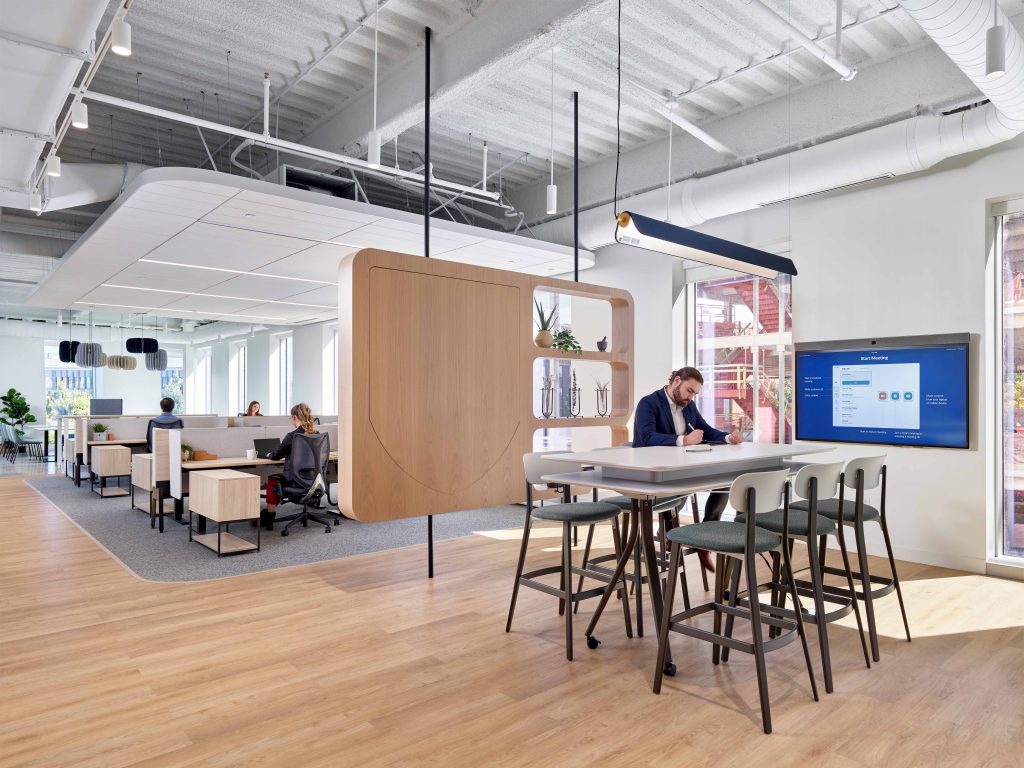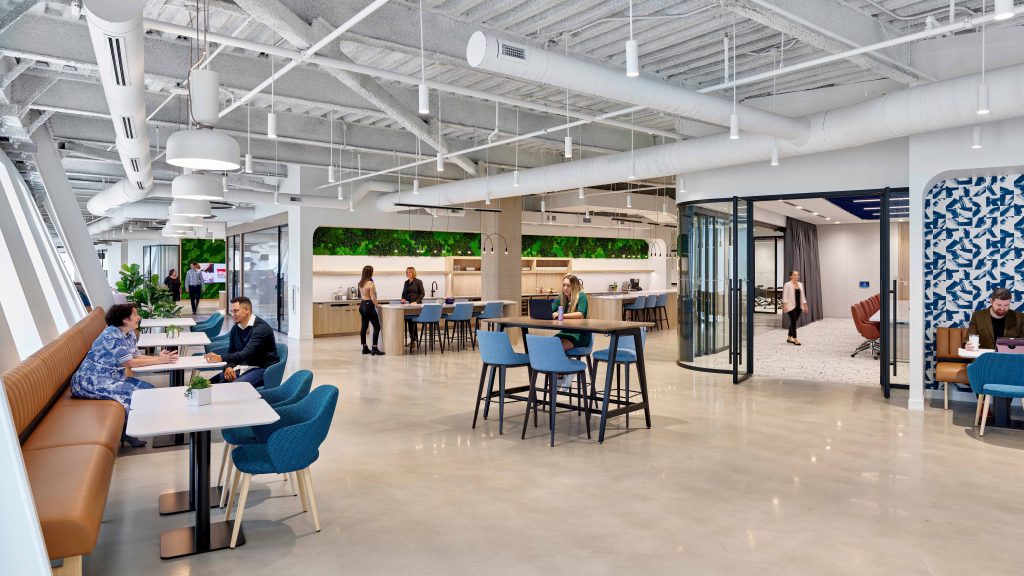
Principal and Corporate Practice Leader Debra Breslow shares how to blend remote-first and in-person collaboration in a way that supports employee health and workplace culture. Photography by Jeffrey Totaro
The pandemic has undeniably altered the landscape of workplace design, as companies continue to grapple with worker demands for hybrid schedules and flexible work practices. Where firms at one time may have tried to recruit talent and retain with a host of in-office services and amenities, businesses are now searching for ways to support their staff by nurturing a sense of wellness, equity and balance through workplace design.
From Fortune 10 companies to local non-profits, companies are starting to embrace the remote-first work environment, based around the same fundamental principles of universal and equitable design. These new workplaces must be adaptable, with a focus on promoting employee health and a respect for neurodiversity and biophilia.
The role of the designer, meanwhile, has also evolved as the importance of workplace design continues to make unprecedented inroads with C-suite leaders. As trusted advisors, we need to maintain a holistic vision, from start to finish, in order to these bring successful remote-first projects to life.

What is a Remote-First Workplace?
Remote-first is an organizational strategy that prioritizes remote work as the primary option for most, if not all, employees. Often, this approach allows companies to expand their hiring to attract top talent nationally, or even internationally. But what happens when a company wants to maintain a physical space to encourage culture, collaboration and community among their staff? Enter the remote-first workplace.
Take, for example, Rite Aid’s new Collaboration Center, which last summer became one of the first corporate headquarters to emerge from the pandemic as 100% remote. With no permanently designated offices, this space includes every scale of meeting space, fully integrated technology, a state-of-the-art collaboration area, and a focus zone to meet the needs of local, regional, national and global users and visitors. It also prioritizes health and hospitality, with a special nourishment center and onsite concierge service to provide all the amenities that a remote and visiting workforce may need—think an IT genius bar, phone rooms, a wellness and respite room, as well as designated spaces for showers, luggage and lockers.
While these features accommodate the needs of Rite Aid’s workforce, it is important to acknowledge that every remote workspace will be different. It is essential that designers work with the client to build out a workplace strategy team consisting of both internal and external shareholders. This group will provide crucial input, while also helping to execute a vision that is true to the company’s values. But it can also be a key catalyst for collaboration. An internal workplace team will often broach important topics that require solutions in the new remote-first headquarters, such as mail, security, IT, operations, human resources, daily communications and branding. Typically, this vision is initially championed by the CEO and then led by the internal stakeholder team.
Essential Elements: Biophilia, Neurodiversity and Branding
As workers emerge from the pandemic era, it’s important that they feel comfortable, safe and secure upon reentering the workplace. This can translate to ample amounts natural light, extra wide corridors, and rounded corners. A connection to nature is an essential part of a successful remote-first office strategy, and many studies have shown that biophilic elements can lower blood pressure and create a calming and safe environment. Immediately upon entering the Collaboration Center’s light-filled reception area, for example, the visitor is greeting with the logos of the Rite Aid Enterprise Companies mounted on green moss that is surrounded by a custom wood wall, organic shaped light fixtures above a curved reception desk and views to the greenery outdoors
It is also important to perceive the range of experiences that end-users will have when interacting with the workspace. To that end, effective remote-first office design must reflect diverse ways of thinking, with a mix of spaces that are both active and engaging as well as passive and quiet. For remote users, the workplace must also incorporate a sense of “digital equity,” so that workers are experiencing the space in the same way that an in-person colleague would, by incorporating comprehensive IT and AV systems throughout all meeting and gathering spaces.
Tracking Results
So, what do real-life results look like for companies that decide to institute a remote-first workplace? Rite Aid’s new headquarters has been well received among staff, thanks to the variety of options, technology, flexibility and ease of use. Employees and users also regularly note that biophilia and natural elements, such as access to natural light and acoustics, provide a comfortable and inviting work experience.
Perhaps most surprisingly, the space is in higher demand that originally anticipated. Originally, Rite Aid planned for there to be no full-time, on-site staff. However, as the project evolved, it became clear that at least one on-site office manager—and perhaps more in the future—would be needed to accommodate the popularity of the Collaboration Center.
For any company, moving forward with a remote-first enterprise is an evolving process, and every major project involves a component of change management, or how to articulate new expectations for the space. Of course, there are always large internal operational initiatives that must be completed, addressing everything from technology to operations and mail. But designers play an important role in change management strategies as well. Designers should remain engaged and partner with the internal team to educate staff on how to use the space, by sharing floor plans and hosting tours prior to the return to office.

Tying It All Together
Bringing successful remote-first workspaces online is no easy task, and we are only in the beginning stages of an evolution for companies and their workers. Each project is different, taking on the individual needs and vision of a company. Above, we’ve outlined some best practices for incorporating a sense of wellness, equity and inclusion into the workplace. We recommend working closely with the client to identify new methods of working that blend remote-first and in-person collaboration in a way that supports their brand and culture, through universal design, innovation and healthy living.
About Debra Breslow, NCIDQ, WELL AP
As a leader of Meyer’s Corporate Practice, and a WELL Accredited Professional and strategist, Debra combines her passion for people and design to create engaging spaces that promote belonging, sustainability and wellness. With over 30 years of experience Debra empowers her clients, from Fortune 10 companies to non-profits, to be active participants in the design process. Her workplace strategy expertise has produced exceptional spaces nationwide that emphasize flexibility, wellness, universal design, biophilia, and neurodiversity.
Debra is a professional member of IWBI, WELL AP, IIDA, on the ASID Covid impact taskforce, a professional member of CoreNet and currently is a CoreNet Global DEI Ambassador.
Debra is also a Co-Chair for the One Global Design Workplace Taskforce where industry leaders meet to discuss current and future issues, best practices and innovations for their clients and the design industry. Her passion for the arts put her as advisory Board member for the Philadelphia Arts + Business Council as well as the Neon Museum of St. Louis.